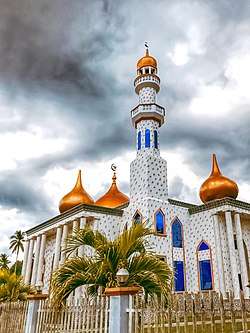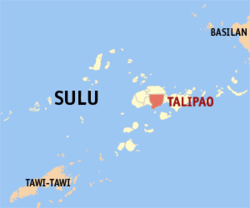Talipao
Talipao, officially the Municipality of Talipao, is a 1st class municipality in the province of Sulu, Philippines. According to the 2015 census, it has a population of 80,255 people.[3]
Talipao | |
|---|---|
| Municipality of Talipao | |
 The Hadja Sitti Raya Mosque | |
 Map of Sulu with Talipao highlighted | |
OpenStreetMap 
| |
.svg.png) Talipao Location within the Philippines | |
| Coordinates: 5°58′34″N 121°06′31″E | |
| Country | |
| Region | Bangsamoro Autonomous Region in Muslim Mindanao (BARMM) |
| Province | Sulu |
| District | 1st District |
| Barangays | 52 (see Barangays) |
| Government | |
| • Type | Sangguniang Bayan |
| • Mayor | Nivocadnezar I. Tulawie |
| • Vice Mayor | Zulficar T. Tulawie |
| • Congressman | Samier A. Tan |
| • Electorate | 26,088 voters (2019) |
| Area | |
| • Total | 380.57 km2 (146.94 sq mi) |
| Population (2015 census)[3] | |
| • Total | 80,255 |
| • Density | 210/km2 (550/sq mi) |
| • Households | 12,190 |
| Economy | |
| • Income class | 1st municipal income class |
| • Poverty incidence | 58.05% (2015)[4] |
| • Revenue (₱) | 158,397,277.21 (2016) |
| Time zone | UTC+8 (PST) |
| ZIP code | 7403 |
| PSGC | |
| IDD : area code | +63 (0)68 |
| Climate type | tropical climate |
| Native languages | Tausug Tagalog |
| Website | www |
Etymology
The municipality of Talipao derived its name from a certain couple, “Tal” and “Pao”, that of the husband’s and wife’s name respectively.
History
From the district of Jolo, it was transformed into a full-pledged municipality on July 1, 1957, under the provision of the Department of Mindanao and Sulu Administrative Code.
Geography
The Municipality of Talipao’s total area coverage is approximately 38,057.00 hectares. This constitute more or less 20.63% of Sulu’s total land area. It is bounded on the north by the municipality of Patikul; on the south by Sulu Sea; on the east by the municipality of Panglima Estino; and by the municipality of Maimbung on its west side.
The municipality of Talipao lies right in the mid portion of Jolo island with its Barangay Poblacion basically situated in the innermost central part of the municipality. From the capital town of Jolo, Talipao is connected with concrete-type national road which is approximately 22.8 kilometres (14.2 mi) away from the Sulu Provincial Capitol Complex.
Barangays
Talipao is politically subdivided into 52 barangays.
- Andalan
- Bagsak
- Bandang
- Bilaan (Poblacion)
- Bud Bunga
- Buntod
- Buroh
- Dalih
- Gata
- Kabatuhan Bilaan
- Kabatuhan Tiis
- Kabungkol
- Kagay
- Kahawa
- Kandaga
- Kanlibot
- Kiutaan
- Kuhaw
- Kulamboh
- Kuttong
- Lagtoh
- Lambanah
- Liban
- Liu-Bud Pantao
- Lower Binuang
- Lower Kamuntayan
- Lower Laus
- Lower Sinumaan
- Lower Talipao
- Lumbayao
- Lumping Pigih Daho
- Lungkiaban
- Mabahay
- Mahala
- Mampallam
- Marsada
- Mauboh
- Mungit-mungit
- Niog-Sangahan
- Pantao
- Samak
- Talipao Proper
- Tampakan
- Tiis
- Tinggah
- Tubod
- Tuyang
- Upper Binuang
- Upper Kamuntayan
- Upper Laus
- Upper Sinumaan
- Upper Talipao
Demographics
| Year | Pop. | ±% p.a. |
|---|---|---|
| 1918 | 5,871 | — |
| 1939 | 11,064 | +3.06% |
| 1948 | 8,650 | −2.70% |
| 1960 | 18,553 | +6.56% |
| 1970 | 32,111 | +5.63% |
| 1975 | 15,612 | −13.47% |
| 1980 | 25,853 | +10.61% |
| 1990 | 66,261 | +9.87% |
| 1995 | 66,568 | +0.09% |
| 2000 | 73,015 | +2.00% |
| 2007 | 85,920 | +2.27% |
| 2010 | 75,173 | −4.75% |
| 2015 | 80,255 | +1.25% |
| Source: Philippine Statistics Authority[3][5][6][7] | ||
Climate
| Climate data for Talipao, Sulu | |||||||||||||
|---|---|---|---|---|---|---|---|---|---|---|---|---|---|
| Month | Jan | Feb | Mar | Apr | May | Jun | Jul | Aug | Sep | Oct | Nov | Dec | Year |
| Average high °C (°F) | 27 (81) |
27 (81) |
27 (81) |
28 (82) |
28 (82) |
28 (82) |
28 (82) |
28 (82) |
28 (82) |
28 (82) |
28 (82) |
27 (81) |
28 (82) |
| Average low °C (°F) | 26 (79) |
26 (79) |
26 (79) |
27 (81) |
27 (81) |
27 (81) |
27 (81) |
27 (81) |
27 (81) |
27 (81) |
27 (81) |
27 (81) |
27 (81) |
| Average precipitation mm (inches) | 170 (6.7) |
130 (5.1) |
125 (4.9) |
122 (4.8) |
229 (9.0) |
286 (11.3) |
254 (10.0) |
248 (9.8) |
182 (7.2) |
257 (10.1) |
233 (9.2) |
188 (7.4) |
2,424 (95.5) |
| Average rainy days | 18.3 | 15.3 | 15.2 | 14.6 | 22.8 | 24.0 | 24.3 | 23.3 | 20.5 | 22.6 | 21.9 | 19.3 | 242.1 |
| Source: Meteoblue[8] | |||||||||||||
References
- "Municipality". Quezon City, Philippines: Department of the Interior and Local Government. Retrieved 31 May 2013.
- "Province: Sulu". PSGC Interactive. Quezon City, Philippines: Philippine Statistics Authority. Retrieved 12 November 2016.
- Census of Population (2015). "ARMM – Autonomous Region in Muslim Mindanao". Total Population by Province, City, Municipality and Barangay. PSA. Retrieved 20 June 2016.
- "PSA releases the 2015 Municipal and City Level Poverty Estimates". Quezon City, Philippines. Retrieved 12 October 2019.
- Census of Population and Housing (2010). "ARMM – Autonomous Region in Muslim Mindanao". Total Population by Province, City, Municipality and Barangay. NSO. Retrieved 29 June 2016.
- Censuses of Population (1903–2007). "ARMM – Autonomous Region in Muslim Mindanao". Table 1. Population Enumerated in Various Censuses by Province/Highly Urbanized City: 1903 to 2007. NSO.
- "Province of Sulu". Municipality Population Data. Local Water Utilities Administration Research Division. Retrieved 17 December 2016.
- "Talipao, Sulu : Average Temperatures and Rainfall". Meteoblue. Retrieved 31 January 2019.